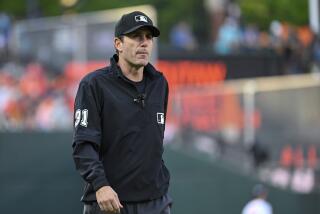Out of the Blue, Another Legal Hassle
- Share via
Let’s see ... Richie Phillips is no longer a factor, the umpires’ union has been reorganized, several perceived militants and incompetents have been weeded out, there is no longer a distinction between American and National League umpires and still baseball can’t avoid legal problems with the men in ... well, sometimes it’s still blue and sometimes it’s red, gray or white. Only the Angels change their uniform colors more often.
Lawyers for the new World Umpires Assn. filed two grievances last week and baseball went into federal court to challenge the union’s right to arbitration on one of the grievances--even though the union insists that it isn’t making a complaint about what baseball apparently thinks it is.
Putting the complexities aside, the bottom line is the umpires’ continuing concern that they are too often under the scrutiny of Big Brother.
Last year, amid baseball’s desire for lower pitch counts and a larger strike zone that would fit the rulebook definition, they were angered by the e-mail from Sandy Alderson, executive vice president for baseball operations, that ordered one umpire to “hunt for more strikes.”
Now, they have filed grievances over a computerized system that monitors their ball and strike calls. The QuesTec Umpire Information System has been installed in four locations at about half a dozen parks. The initial intent was to use QuesTec as a training tool, but this season it has been used to inform umpires when the computer purportedly shows their ball and strike calls to be wrong too much of the time--as veteran umpire and union president John Hirschbeck was accused of in a recent letter.
The union has serious concerns over the system’s accuracy, and in a statement Friday said the apparatus has difficulty tracking certain breaking pitches, there is inconsistency in where QuesTec technicians draw the top and bottom of the strike zone and, as with last year’s pitch count directives, it “interjects an extraneous element into the game and pressures umpires to compete with the machine rather than giving their full attention to calling the game as they see it unfold.... “
The union has asked the commissioner’s office for information on the system and requested answers to 50 system-related questions posed in writing to Alderson, but has received no response. Rob Manfred, baseball’s top labor lawyer, said the refusal to respond was based on the bargaining agreement, which calls for a joint committee of supervisors and umpires to meet after the season to analyze the system and determine rating standards.
Manfred said he did not want another distracting legal issue during the season, but the union, in its statement, said that as long as the system was being used to evaluate umpires, it did not want to wait until the season ended for answers.
Two-Party System
It’s not a new story, but it continues to be a statistically compelling one that reflects what the National League West is up against in trying to dethrone the Arizona Diamondbacks, and what the Diamondbacks are up against in trying to repeat.
As Randy Johnson faces the San Diego Padres today, he and Curt Schilling are a combined 7-0 against the West this year and 34-4 over the last two years.
The Arizona aces are also a combined 29-6 overall, on pace to match or surpass last year’s 43-12 total, and their performance alone would suggest a division runaway.
Then again, it takes more than two guns in the West, and for the second consecutive season the Diamondbacks are trying to overcome the remainder of their rotation, along with the Dodgers and San Francisco Giants.
They used nine other starters who combined for a 33-39 record last year and had used four--Rick Helling, Miguel Batista, Brian Anderson and Todd Stottlemyre--who were a combined 16-24 this year before Helling went on the disabled list with a sprained ankle and John Patterson made his major league debut Saturday night.
Patterson, 24, was a first-round draft choice of Montreal in 1996, slipped through the same loophole that Travis Lee did to sign with Arizona for a bonus of $6.075 million and promptly illustrated the risks inherent in giving amateur pitchers that kind of package by requiring elbow and shoulder operations. He had a modest record of 6-4 with a 4.71 earned-run average in triple-A this year, but the Diamondbacks, who have had their eye on Kenny Rogers of Texas, were out of internal alternatives.
Happy Days
It has been a long year for former Angel Chuck Finley, starting with that spring altercation with his wife and their ensuing divorce, and continuing with a summer of poor support by the Cleveland Indians, who averaged 2.9 runs in his last 15 starts as he went 4-11 with a 4.44 ERA overall. However, the veteran southpaw got a reprieve when he was traded to the St. Louis Cardinals, hurting for a Darryl Kile replacement. Finley, at 39, is likely to get another playoff opportunity, and the Cardinals’ only financial obligation is $1 million of the $2 million remaining on his $5-million salary this year.
The Indians are obligated for the other $1 million, along with the remaining $8 million of his $11-million signing bonus.
A major rebuilding project has not left General Manager Mark Shapiro the most popular figure in Cleveland and he has had to look for sales pitches where he can find them. He predicted that double-A outfielder Luis Garcia, obtained for Finley, will be starting in Cleveland within two years and “could hit ... 30 home runs.”
More to Read
Go beyond the scoreboard
Get the latest on L.A.'s teams in the daily Sports Report newsletter.
You may occasionally receive promotional content from the Los Angeles Times.






